Home » Gemstones » Opal » Common Opal
Common Opal Occurs in a Spectrum of Colors
Don't allow the name "common" to fool you. Common opal is uncommonly colorful.
Author: Hobart M. King, PhD, GIA Graduate Gemologist

A spectrum of common opal colors: Pink opal from Peru; yellow and orangy opal from Australia and Nevada; green opal from Peru and Kenya; Blue opal from Oregon and Peru; purple opal from Mexico. The common opals above have been used to make beautiful beads, cabochons and tumbled stones.
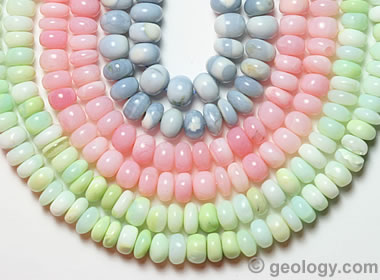
Opal Beads: Beads cut from green, pink, and blue common opal found in Peru. These beads measure approximately 7 millimeters in diameter. We sent one of the green beads to the lab at the Gemological Institute of America, and they identified it as natural opal. [1]
What is Common Opal?
"Common opal," sometimes known as "potch", is a variety of opal that does not exhibit the flash and "play-of-color" seen in precious opal. However, common opal occurs in a variety of beautiful colors that includes a range of wonderful pastels. Common opal is found in a greater range of colors than most other gems.
At present and in the past, common opal is not often seen in commercial or designer jewelry. That is because it is not widely known and supplies can be limited. If any gem is underappreciated, common opal is it. But, that comes with a bonus. Common opal is not extremely expensive. Beautiful pieces can be purchased for prices that anyone can afford.
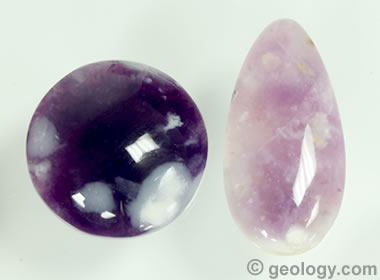
Morado opal: Common opal with a purple color mined in some parts of Mexico is sold under the trade name "Morado" opal. It can be cut into beautiful cabochons.
Geologic Occurrence
Common opal is found in many of the same environments as precious opal. It is often found associated with volcanic activity - especially ashfalls. It is also commonly found in sedimentary rocks underlying areas with an arid climate. There, the minimal rainfall dissolves silica during infiltration and deposits it at depth in fractures and cavities.
Most deposits of common opal are of limited geographic extent and volume. At the present time, none are large enough for highly mechanized mining. Many are so small that a team or a family of just a few people can work them out in a few field seasons or less.
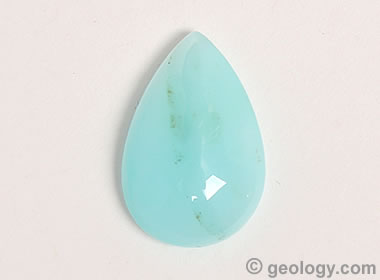
Peruvian opal: A beautiful blue common opal cut into a teardrop cabochon from material mined in Peru. This cabochon weighs 2.3 carats and measures 13 x 8 millimeters in size.
Geographic Distribution
Small deposits of common opal are numerous and found throughout the world. Most of these contain opal of uninteresting colors such as off-white or tan. But, small deposits of common opal of wonderful color are produced today in the areas listed below.
- Peru is known for its common opal in pastel colors of pink, blue and green. These are often cut into tiny beads and cabochons.
- Oregon has produced beautiful common opal in blue, pink and yellow. Much of the petrified wood found under Oregon's volcanic ashfalls is opalized wood.
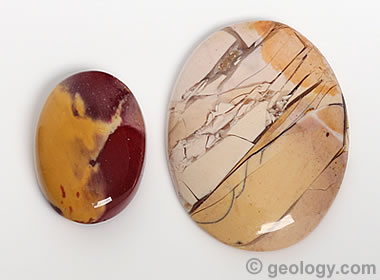
Mookaite Opal: Some mookaite has the refractive index and specific gravity of opal. The cabochon on the left has the familiar color pattern of mookaite. The cabochon on the right has the less-familiar brecciated appearance. Both can be properly called "common opal". Don't believe it? Here's the GIA lab report for the stone on the left.
- Mexico produces a unique purple common opal known as "Morado" that can be made into beautiful cabochons. Much of the fire opal mined in Mexico could be considered "common opal" because it lacks play-of-color.
- Nevada produces much common opal that ranges from bright white to buttery yellow in color. These sometimes contain black dendrites and moss. Many specimens are fluorescent, producing a bright green glow under an ultraviolet lamp. Much of Nevada's opal is subject to crazing and color changes after mining.
- Western Australia produces a radiolarite known as Mookaite, which is often opaline. It is used to produce colorful cabochons, beads, and tumbled stones patterned in white, tan, yellow, red and maroon colors. Some of the peanut wood produced in Western Australia is opaline.
- Kenya produces common opal in a range of olive green colors. It is often cut into cabochons and used to make tumbled stones.
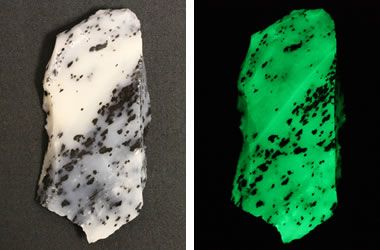
Fluorescent Opal: This specimen of mossy common opal rough from Virgin Valley, Nevada fluoresces a brilliant green under UV light. The photo on the left was taken under normal light, and the photo on the right was taken under a short-wave ultraviolet lamp.
Fluorescent Common Opal
Most opal will fluoresce weakly under an ultraviolet lamp. However, some specimens are strongly fluorescent. One locality that yields opal with very strong fluorescence is Virgin Valley, Nevada, from which many specimens will glow with a spectacular green fluorescence.
The cause of this fluorescence has been attributed to the presence of small amounts of uranium in the opal. In the 1950s, the United States Geological Survey sampled rocks throughout the Virgin Valley area and found that many of them, including some of the opals, were uraniferous. Most specimens contained trace amounts of uranium, but some specimens contained up to 0.12 percent uranium by weight. The USGS study is: Virgin Valley Opal District, Humboldt County, Nevada, by M.H. Staatz and H.L. Bauer, United States Geological Survey Circular 142, 1951.
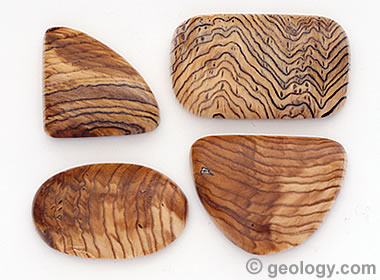
Herringbone Sequoia: These cabochons were cut from an opalized wood known as Herringbone Sequoia by Greta Schneider. The rough was found in the Snake River / Hell's Canyon area by an old-time rockhound in the mid-1900s and was sold as part of his estate. It is uncertain if it was found on the Idaho or Oregon side of the canyon. Whichever state it came from, it is a beautiful and unique material. It is definitely opalized wood (specific gravity = 2.106, spot refractive index = 1.48).
| Common Opal Information |
|
[1] Gemological Report 2205169258 issued by the Gemological Institute of America Laboratory, April 3, 2019.
|
Opalized Wood
When wood is petrified, the cell walls are replaced by a mineral or mineraloid, and the cell cavities are usually infilled by the same material. The most common replacement / infilling material is a form of microcrystalline quartz known as chalcedony. Chalcedony is the material that preserved much of the wood in the world-famous Petrified Forest of Arizona.
Less often, the replacement material is opal. Petrified wood of this type is referred to as opalized wood. Wood replaced by chalcedony can be separated from wood replaced by opal using a few common tests, or it can be sent to a laboratory for positive identification. The diagnostic tests include Mohs hardness, specific gravity, and spot refractive index. Separating values are shown in the table below.
| Chalcedony | Opal | |
| Mohs Hardness | 6.5 to 7 | 5 to 6.5 |
| Specific Gravity | 2.58 to 2.62 | 2.1 to 2.2 |
| Spot Refractive Index | 1.53 to 1.54 | 1.43 to 1.46 |
| More Gemstones |
 |
Tourmaline |
 |
Fancy Sapphires |
 |
Diamond |
 |
Canadian Diamond Mines |
 |
Birthstones |
 |
Pictures of Opal |
 |
Fire Agate |
 |
Blue Gemstones |

Find Other Topics on Geology.com:

|

| ||

|

| ||

|

| ||

|

|
